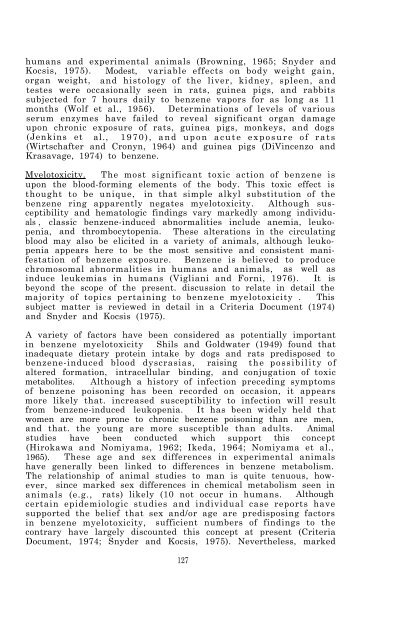Review of Inhalants - ARCHIVES - National Institute on Drug Abuse
Review of Inhalants - ARCHIVES - National Institute on Drug Abuse
Review of Inhalants - ARCHIVES - National Institute on Drug Abuse
Create successful ePaper yourself
Turn your PDF publications into a flip-book with our unique Google optimized e-Paper software.
humans and experimental animals (Browning, 1965; Snyder and<br />
Kocsis, 1975). Modest, variable effects <strong>on</strong> body weight gain,<br />
organ weight, and histology <str<strong>on</strong>g>of</str<strong>on</strong>g> the liver, kidney, spleen, and<br />
testes were occasi<strong>on</strong>ally seen in rats, guinea pigs, and rabbits<br />
subjected for 7 hours daily to benzene vapors for as l<strong>on</strong>g as 11<br />
m<strong>on</strong>ths (Wolf et al., 1956). Determinati<strong>on</strong>s <str<strong>on</strong>g>of</str<strong>on</strong>g> levels <str<strong>on</strong>g>of</str<strong>on</strong>g> various<br />
serum enzymes have failed to reveal significant organ damage<br />
up<strong>on</strong> chr<strong>on</strong>ic exposure <str<strong>on</strong>g>of</str<strong>on</strong>g> rats, guinea pigs, m<strong>on</strong>keys, and dogs<br />
(Jenkins et al., 1970), and up<strong>on</strong> acute exposure <str<strong>on</strong>g>of</str<strong>on</strong>g> rats<br />
(Wirtschafter and Cr<strong>on</strong>yn, 1964) and guinea pigs (DiVincenzo and<br />
Krasavage, 1974) to benzene.<br />
Myelotoxicity. The most significant toxic acti<strong>on</strong> <str<strong>on</strong>g>of</str<strong>on</strong>g> benzene is<br />
up<strong>on</strong> the blood-forming elements <str<strong>on</strong>g>of</str<strong>on</strong>g> the body. This toxic effect is<br />
thought to be unique, in that simple alkyl substituti<strong>on</strong> <str<strong>on</strong>g>of</str<strong>on</strong>g> the<br />
benzene ring apparently negates myelotoxicity. Although susceptibility<br />
and hematologic findings vary markedly am<strong>on</strong>g individuals<br />
, classic benzene-induced abnormalities include anemia, leukopenia,<br />
and thrombocytopenia. These alterati<strong>on</strong>s in the circulating<br />
blood may also be elicited in a variety <str<strong>on</strong>g>of</str<strong>on</strong>g> animals, although leukopenia<br />
appears here to be the most sensitive and c<strong>on</strong>sistent manifestati<strong>on</strong><br />
<str<strong>on</strong>g>of</str<strong>on</strong>g> benzene exposure. Benzene is believed to produce<br />
chromosomal abnormalities in humans and animals, as well as<br />
induce leukemias in humans (Vigliani and Forni, 1976). It is<br />
bey<strong>on</strong>d the scope <str<strong>on</strong>g>of</str<strong>on</strong>g> the present. discussi<strong>on</strong> to relate in detail the<br />
majority <str<strong>on</strong>g>of</str<strong>on</strong>g> topics pertaining to benzene myelotoxicity . This<br />
subject matter is reviewed in detail in a Criteria Document (1974)<br />
and Snyder and Kocsis (1975).<br />
A variety <str<strong>on</strong>g>of</str<strong>on</strong>g> factors have been c<strong>on</strong>sidered as potentially important<br />
in benzene myelotoxicity Shils and Goldwater (1949) found that<br />
inadequate dietary protein intake by dogs and rats predisposed to<br />
benzene-induced blood dyscrasias, raising the possibility <str<strong>on</strong>g>of</str<strong>on</strong>g><br />
altered formati<strong>on</strong>, intracellular binding, and c<strong>on</strong>jugati<strong>on</strong> <str<strong>on</strong>g>of</str<strong>on</strong>g> toxic<br />
metabolites. Although a history <str<strong>on</strong>g>of</str<strong>on</strong>g> infecti<strong>on</strong> preceding symptoms<br />
<str<strong>on</strong>g>of</str<strong>on</strong>g> benzene pois<strong>on</strong>ing has been recorded <strong>on</strong> occasi<strong>on</strong>, it appears<br />
more likely that. increased susceptibility to infecti<strong>on</strong> will result<br />
from benzene-induced leukopenia. It has been widely held that<br />
women are more pr<strong>on</strong>e to chr<strong>on</strong>ic benzene pois<strong>on</strong>ing than are men,<br />
and that. the young are more susceptible than adults. Animal<br />
studies have been c<strong>on</strong>ducted which support this c<strong>on</strong>cept<br />
(Hirokawa and Nomiyama, 1962; Ikeda, 1964; Nomiyama et al.,<br />
1965). These age and sex differences in experimental animals<br />
have generally been linked to differences in benzene metabolism.<br />
The relati<strong>on</strong>ship <str<strong>on</strong>g>of</str<strong>on</strong>g> animal studies to man is quite tenuous, however,<br />
since marked sex differences in chemical metabolism seen in<br />
animals (e.g., rats) likely (10 not occur in humans. Although<br />
certain epidemiologic studies and individual case reports have<br />
supported the belief that sex and/or age are predisposing factors<br />
in benzene myelotoxicity, sufficient numbers <str<strong>on</strong>g>of</str<strong>on</strong>g> findings to the<br />
c<strong>on</strong>trary have largely discounted this c<strong>on</strong>cept at present (Criteria<br />
Document, 1974; Snyder and Kocsis, 1975). Nevertheless, marked<br />
127
















